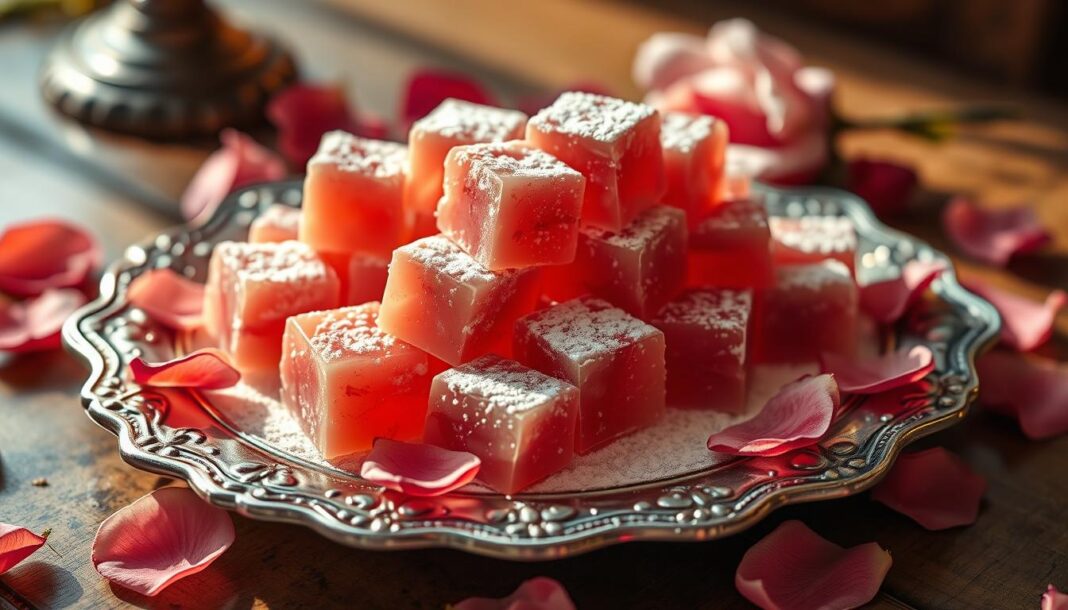Since reading The Lion, The Witch and the Wardrobe as kids, many of us have been enchanted by the magical world of Narnia and the tempting Turkish Delight that the White Witch uses to lure Edmund Pevensie into betrayal.
We explore the significance of this iconic confection in C.S. Lewis’s beloved series, The Chronicles of Narnia, and provide a detailed guide on recreating the authentic Turkish Delight at home, bringing a touch of Narnia’s magic into our kitchens.
Key Takeaways
- Understand the cultural context and real-world origins of Turkish Delight.
- Learn how to recreate authentic Turkish Delight as portrayed in The Lion, The Witch & The Wardrobe.
- Discover the literary significance of Turkish Delight in The Chronicles of Narnia.
- Enhance your appreciation of both the book and the food itself.
- Bring a piece of fantasy literature into your kitchen by making Turkish Delight at home.
The Magical Allure of Turkish Delight in Narnia
In the realm of Narnia, Turkish Delight is more than just a sweet treat; it’s a symbol of temptation and betrayal. The White Witch’s use of this confection to lure Edmund Pevensie into her trap is a pivotal moment in The Lion, the Witch and the Wardrobe, showcasing C.S. Lewis’s mastery of using food as a narrative device.
The story, which gained renewed popularity with the 2005 feature film adaptation, is set against the backdrop of World War II-era Britain, where sweets were a rare and coveted luxury. This context adds depth to the White Witch’s offer of Turkish Delight to Edmund, making it a tantalizing promise of power and indulgence in a world where such pleasures were scarce.
Edmund’s Temptation by the White Witch
The scene where Edmund first encounters the White Witch and is offered the enchanted Turkish Delight is crucial to the narrative, as it sets the stage for much of the conflict that follows. The White Witch’s deliberate use of this sweet treat to tempt Edmund highlights the psychological impact of food on characters in the story. By accepting the Turkish Delight, Edmund is drawn into a world of magic and deception, illustrating the powerful symbolism of sweets in the narrative.
| Element | Significance in Narnia | Impact on Narrative |
|---|---|---|
| Turkish Delight | Symbol of temptation and betrayal | Sets conflict in motion |
| White Witch | Represents deceit and power | Drives plot forward |
| Edmund’s Choice | Represents human weakness | Illustrates moral struggle |
Why This Sweet Treat Captivated Readers’ Imaginations
The description of Turkish Delight in The Chronicles of Narnia not only captivated readers with its magical qualities but also introduced many to a previously unfamiliar confection. The context of wartime Britain, where sweets were rationed, made the promise of Turkish Delight even more alluring. This combination of novelty, temptation, and the magical context has cemented Turkish Delight’s place as one of literature’s most famous treats, capturing the imaginations of readers for generations.
By exploring the role of Turkish Delight in Narnia, we gain insight into how C.S. Lewis used this sweet treat to weave a tale that continues to enchant readers. The allure of Turkish Delight lies not just in its taste but in the magic and context it brings to the narrative, making it a timeless element of the Narnia series.
What Is Turkish Delight? The Real-World Lokum
The enchanting world of Turkish Delight, also known as lokum, is a realm where sugar, starch, and flavorings come together in a delightful gel-like treat. Turkish Delights are a gummy treat that originated in Turkey, made from a gel created by heating sugar and starch. This process results in a texture that is somewhere between gumdrops and Jell-O.

While you might think Turkish Delights would be overly sweet due to their high sugar content, the starch really mellows out the taste and lets the citric acid and extracts shine through. Traditionally, Turkish Delights are made from lokum, which is prepared by heating sugar syrup and a cornstarch slurry mixture until thickened into a gel. This gel is then flavored—usually with something like rosewater—and sometimes includes add-ins like pistachios or walnuts.
The History and Cultural Significance of Turkish Delight
Turkish Delight, or lokum, has a rich history that spans centuries in Middle Eastern and Turkish culture. It has been served in Turkish homes for centuries as a symbol of hospitality and celebration. The cultural significance of lokum extends beyond mere candy; it’s a treat that has been enjoyed by people for years, often served during special occasions.
The traditional preparation of lokum involves a careful balance of sugar, starch, and flavorings that creates its distinctive chewy, gel-like texture. Rosewater became the classic flavoring for Turkish Delight, though many variations exist, including those with pistachios, lemon, or orange blossom water.
Traditional Ingredients and Flavors
The traditional ingredients used in making Turkish Delight include sugar, cornstarch, and water. The rose flavor, achieved through the use of rosewater, is particularly iconic in Turkish Delight. The use of pistachios and other nuts adds texture and flavor variety to this traditional food.
Understanding the traditional ingredients and flavors of Turkish Delight helps appreciate its significance in Turkish culture. It’s not just a delightful treat but also a confection with deep roots in history and tradition.
Recreating Turkish Delight from The Lion, The Witch & The Wardrobe

Recreating the enchanting Turkish Delight from The Lion, The Witch & The Wardrobe is a culinary adventure that brings a touch of Narnia to your kitchen. This traditional confectionery delight has captivated readers’ imaginations since C.S. Lewis’s classic tale was first published. With its delicate balance of flavors and textures, Turkish Delight is a sweet treat that’s sure to transport you to a world of wonder.
Essential Ingredients and Equipment
To create authentic Turkish Delight, you’ll need a few essential ingredients and some specialized equipment. The key components include sugar, water, cornstarch slurry, and rosewater extract (optional). You’ll also require a heavy-bottomed pot and a candy thermometer to ensure precise temperature control.
The quality of your ingredients will directly impact the final product, so be sure to use high-grade sugar, cornstarch, and rosewater extract. A candy thermometer is also crucial, as it allows you to accurately monitor the temperature of the mixture as it cooks.
Step-by-Step Recipe Instructions
Now that you have your ingredients and equipment ready, it’s time to begin crafting your Turkish Delight. Start by combining sugar and water in a heavy-bottomed pot, heating the mixture over medium heat until it reaches the soft-ball stage (250°F). This critical step requires patience and attention to detail, as the precise temperature is essential for achieving the proper texture.
Once the syrup has reached the desired temperature, gradually add the cornstarch slurry, stirring constantly to prevent lumps from forming. Continue cooking the mixture until it thickens and turns a translucent gel-like consistency.
Remove the pot from the heat and stir in your preferred flavorings, such as rosewater extract. Pour the lokum mixture into a greased surface and allow it to set at room temperature for 5-10 hours.
Setting and Cutting Your Turkish Delight
After the lokum has set, dust the top with cornstarch and slice it into bite-sized pieces. Dredge the Turkish Delight pieces in powdered sugar to coat, then store them in an airtight container with additional powdered sugar on top.
With these simple steps, you’ll be able to create your own authentic Turkish Delight, just like the White Witch’s tempting treat from The Lion, The Witch & The Wardrobe.
Tips for Perfect Turkish Delight Every Time
The secret to perfect Turkish Delight lies in understanding the science behind its creation. Making this traditional confectionery involves a delicate balance of sugar, water, and flavorings, all of which must be carefully controlled to achieve the desired texture and consistency.
Temperature Control and Timing
Temperature accuracy is crucial when making Turkish Delight. A candy thermometer is essential for ensuring that the sugar mixture reaches the correct temperature of 250°F. This precise temperature control is necessary for achieving the right set and texture. We also recommend stirring the lokum regularly while it’s cooking to prevent sticking and ensure even consistency.
Flavor Variations and Add-ins
While traditional rosewater is a classic flavor for Turkish Delight, you can experiment with other flavors to create unique variations. Consider adding a hint of citrus, mint, or various spice combinations to give your lokum a personal touch. When introducing new flavors, be sure to balance them with the other ingredients to maintain the desired texture and consistency.

Troubleshooting Common Issues
Even with careful preparation, issues can arise when making Turkish Delight. If your lokum fails to set properly, check that your syrup temperature reached 250°F. If it’s too sticky, ensure that it’s set at room temperature, rather than in the fridge. For issues with grainy texture or overly soft consistency, adjust your cooking time and temperature accordingly. Proper storage with plenty of powdered sugar can also help maintain the coating and prevent sticking.
By following these expert tips and understanding the science behind making Turkish Delight, you’ll be well on your way to creating perfect lokum every time. Whether you’re a seasoned candy maker or just starting out, the key to success lies in patience, attention to detail, and a willingness to experiment with new flavors and techniques.
Enjoying Your Homemade Narnia-Inspired Treat
The process of making Turkish Delight at home is a journey that connects us to both the fantastical world of Narnia and the rich culinary heritage of Turkey. As we savor these chewy, powdered sugar-coated gems, we’re reminded of the magical allure that captivated readers in The Lion, The Witch & The Wardrobe.
To fully enjoy your homemade Turkish Delight, consider pairing it with traditional accompaniments like strong Turkish coffee or tea. This delightful treat also makes a wonderful gift or a special addition to any gathering, sparking conversations about The Chronicles of Narnia.
By recreating this beloved confection, we not only bring a bit of Narnia into our homes but also connect with a broader food culture that spans centuries. So, take a piece, close your eyes, and let the taste transport you to a land where magic is real.


